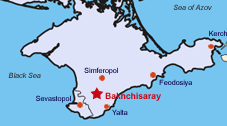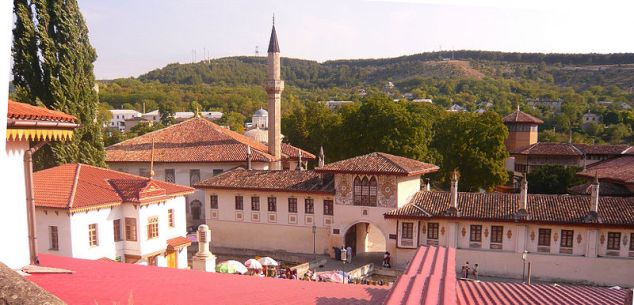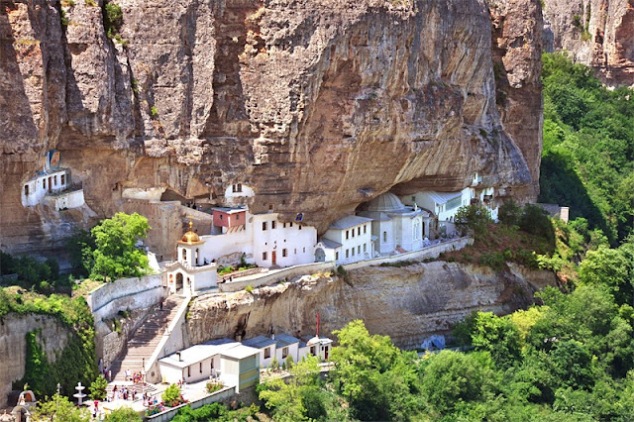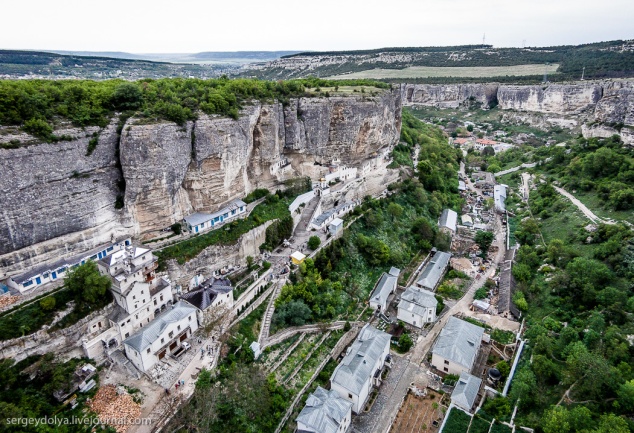Bakhchisaray, or “city in the garden” (from Tatar) is located in a narrow river valley. It is an historical site, an ancient of civilisation. Artefacts found here indicate a human presence dating from the Mesolithic period – between 18000 and 2000 BC.
Perhaps one of the oldest places to visit in Bakhchisaray is Mangup Kale – an historic fortress in the Crimea. In medieval times it was known as Doros. Later it was given the Kipchak name Mangup.
The settlement dates back to the 3rd century AD and was fortified by Justinian I in the mid- 6th century. It was inhabited and governed primarily by Crimean Goths, and became the centre of their autonomous principality, the Metropolis of Doros during the 5th and 7th centuries. It was conquered by the Khazars in the early 8th century, and later in the 8th century was the centre of an unsuccessful Gothic revolt against Khazaria led by Bishop John of Gothia.
The principality of Doros was under Byzantine domination from the mid-9th century to approximately 1000 AD, when it fell under the influence of competing powers – Kievan Rus (the cultural inheritance of the Belarus, Ukrainian and Russian people) and the Kipchak tribal confederacy (a predecessor of the Kazakh Khanate and later modern-day Kazakhstan). The town was severely damaged by an earthquake in the 11th century, yet managed to maintain autonomy during the Mongol conquest of Crimea , although compelled to pay tribute to the Great Khan.
Mangup Kale – A short bus ride out of town will take you to the area where you can hike to the top of the plateau and walk around the Ostrogoth/Byzantine ruins.
Eski-Kermen is another cave city, remarkably well-preserved. Here some 1500 year old frescoes are still visible. It was founded at the end of sixth century AD as a fortress for the Byzantine Empire , existing until the end of the fourteenth century. Little is known of the subsequent history of the city up until the tenth century, but its importance seems to have declined. Since then there was a gradual expansion of the city and it increased in importance, peaking in the twelfth and thirteenth centuries, when the population was probably 3000. In 1299 the city is was destroyed by the Mongolians under the command of Nogaj and never recovered its former glory. Further destruction of the re-built town was carried out by the Mongolian army in 1399 under the command of Edygejam, since which the site has remained uninhabited.
Eski-Kermen cave city.
Another world famous tourist destination is Kachi Kaleon – a Greek cliff city with several cave churches. This is also a short bus ride out of the city.
Researchers are not unanimous as to the probable approximate date of the town’s founding. Some consider it to be a Byzantine fortress founded in the 6th century whilst others are of the opinion that the fortified settlement appeared in the 10th-11th centuries. During the early period of the town’s history, it was mainly populated by Alans, the most powerful of a late Sarmatian tribe of Iranian descent. They began penetrating the Crimea from the 2nd century AD. Settling down in the mountainous Crimea , the Alans adopted Christianity. In written sources the cave town is mentioned in the 13th century under the name of Kyrk-Or (Forty Fortifications).
Kachi Kaleon – A Greek cliff city.
The city of Bakhchysarai was first mentioned in 1502 as the new seat of government and residence of the Crimean Khan, Sahib I Giray in 1532.
Since then, it has been the established capital of the Crimean Khanate and the centre of political and cultural life of the Crimean Tatar people.
The Crimean Tatars, allied to the Ottoman Empire, extended their influence through military campaigns and raids, reaching as far as Moscow .
Khan Devlet Giray was installed as the ruler of the Crimean Khanate in 1551. He is known to have been a skilful politician, who could always take advantage of auspicious conditions. With an army of considerable size at his disposal, Devlet Giray constantly fought with his neighbours, particularly Russia . His raids of 1555 and 1571 were especially devastating for Moscow when the city was burned down. It was believed up to 100,000 civilians were killed or taken to slavery.
The Khan’s Palace in Bakhchisaray – This famous building was the residence of the Khan, the head of the Crimean Tatars, whose capital was Bakhchisaray and also their political, cultural, and religious centre. The palace was built in 1532 by the Tatars’ Russian and slavic slaves, following on from projects by Turkish, Persian, and Italian architects. It comprises 17 buildings, nine inner yards and includes governmental buildings such as the Hall of the Divan (State Council) and the Hall of Embassies. There are two religious buildings, the Small and the Grand palace mosques, the rooms of the Khan and his family, the harem, the baths, and other auxiliary and recreational buildings. Its architecture is in keeping with oriental traditions, blending influences from the Middle East with the proper Tatar style. It is included in the UNESCO Tentative World Heritage List.
Perhaps the most famous artefact in the palace is the Fountain of Tears, which came to popular notice when the famed Russian writer Pushkin visited the city and heard the story of the fountain’s creation.
The story goes that the Khan fell in love with a beautiful woman who was poisoned by a jealous rival in the harem. The Khan was so moved by his loss that he commissioned the fountain in her honour. Tears, in the form of water, pour from a flower at the top that represents an eye. The tears fill a cup representing theHeart, flowing from there to another cup which is Memory, and finally to a spiral at the bottom representing Eternity. If the Khan’s desire was to preserve the sorrow felt for his beloved, then he succeeded beyond his expectations.
The famous Russian ballet was inspired by the 1823 poem of the same title by Alexander Pushkin. With music by Boris Asafyev and choreography by Rostislav Zakharov, the ballet was premiered in Saint Petersburg (then Leningrad) in1934 at the Kirov Academic Theatre of Opera and Ballet (now the Mariinsky Theatre).
The other fascinating place in Bakhchisaray is the Assumption Monastery of the Caves. The white walls and golden domes of the monastery clinging to the sharp mountain cliff is an unforgettable sight. The present monastery was built here by orthodox monks after the previous byzantine one, which dated back to the eighth century, was abandoned. Surprisingly, the monastery, which is Christian, is next to the Khan’s palace, the highest Muslim authority in Crimea , as the Crimean Tatars were tolerant towards other religions and permitted the monastery to be built and developed in their capital city.
The date of the monastery’s foundation is disputed, although local monks assert that it originated as early as the 8th century, being abandoned when Byzantium lost its hold on the region. The current monastic establishment dates back to the 15th century.
During World War II it became a hospital in the USSR`s battle against the fascists and was returned to the Russian Orthodox Church in 1993. Today the monastery has five churches and hosts 60 monks and nuns.
In 1783, after a long series of wars with Ottoman Empire , Russia finally subdued its enemy and incorporated Crimea into the Russian Empire, although Bakhchisaray remained an important cultural centre for the Crimean Tatars.
Tragically for the Crimean Tartars, in 1944 Stalin deported them to Uzbekistan for alleged collaboration with the Nazi occupation regime in Taurida Subdistrict during 1942-1943.
A total of more than 230,000 people were deported. A large number of deportees (more than 100,000 according to a 1960s survey by Crimean Tatar activists) died from starvation or disease as a direct result of this.
Crimean Tatars were allowed to return to Crimea in the late 1980s, where they now form a 12% minority.
In the present day, Tatars resident in Crimea are noted for running successful businesses. They are also well-known for what is termed their “famous eastern hospitality” …a culture in which anyone who steps into a Tatar house is treated as a VIP. Thus they play an important role in contemporary Crimean society.
Bakhchisaray today is a sleepy town of about 35,000 people located in the Crimea, a peninsula historically belonging to Russia .
For nearly 300 years, Bakhchisaray was the hub of a mighty nation that controlled the east-west trade routes that passed north of the Black Sea . It profoundly influenced the fortunes, not only of Russia , but of great empires – Byzantium , the Ottoman Turks and the rich and powerful Islamic Caliphate.





















I all the time emailed this webpage post page tto all my associates, since iff like to
read it then my links will too.
LikeLike